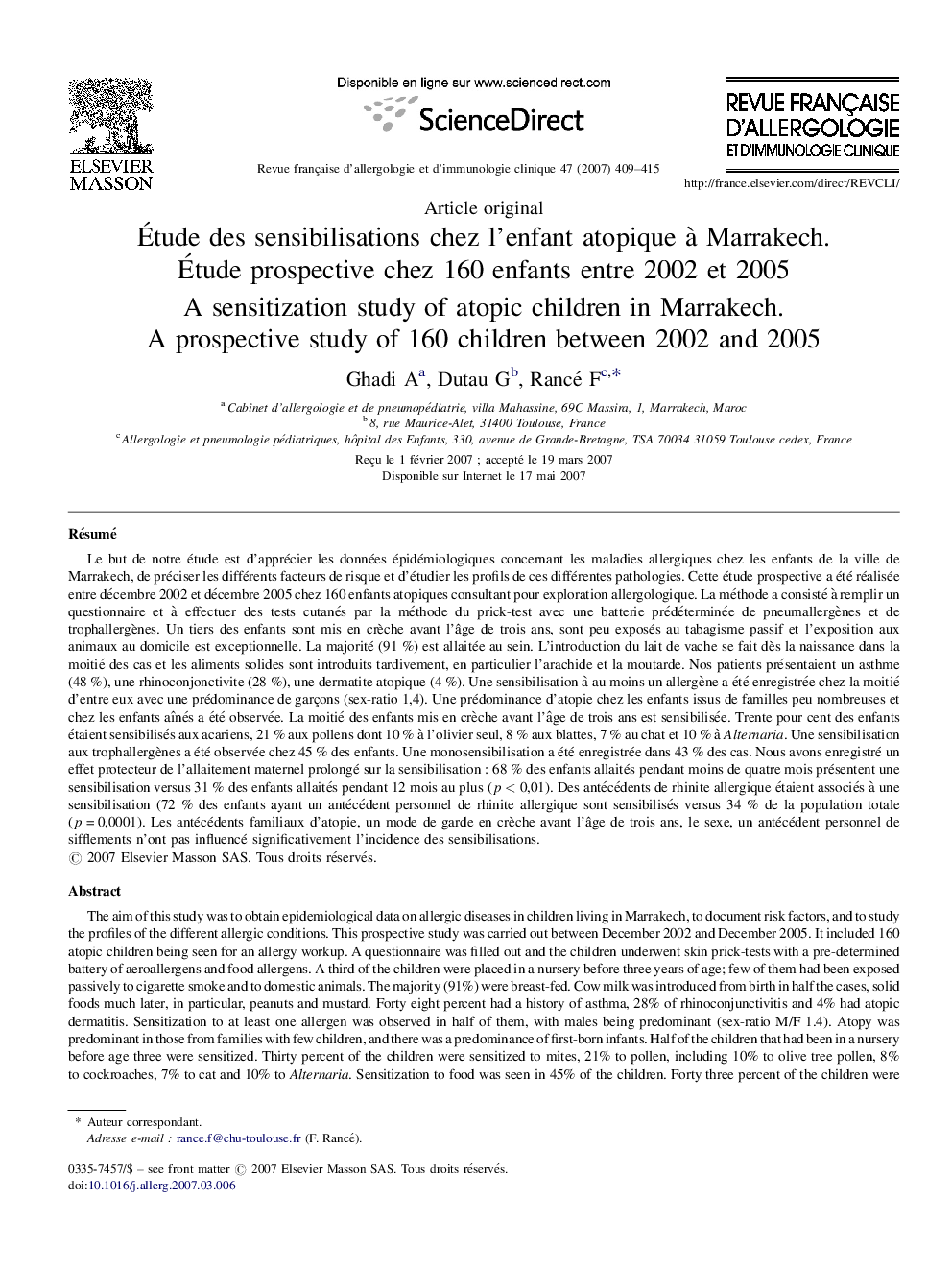| Article ID | Journal | Published Year | Pages | File Type |
|---|---|---|---|---|
| 2770299 | Revue Française d'Allergologie et d'Immunologie Clinique | 2007 | 7 Pages |
RésuméLe but de notre étude est d’apprécier les données épidémiologiques concernant les maladies allergiques chez les enfants de la ville de Marrakech, de préciser les différents facteurs de risque et d’étudier les profils de ces différentes pathologies. Cette étude prospective a été réalisée entre décembre 2002 et décembre 2005 chez 160 enfants atopiques consultant pour exploration allergologique. La méthode a consisté à remplir un questionnaire et à effectuer des tests cutanés par la méthode du prick-test avec une batterie prédéterminée de pneumallergènes et de trophallergènes. Un tiers des enfants sont mis en crèche avant l’âge de trois ans, sont peu exposés au tabagisme passif et l’exposition aux animaux au domicile est exceptionnelle. La majorité (91 %) est allaitée au sein. L’introduction du lait de vache se fait dès la naissance dans la moitié des cas et les aliments solides sont introduits tardivement, en particulier l’arachide et la moutarde. Nos patients présentaient un asthme (48 %), une rhinoconjonctivite (28 %), une dermatite atopique (4 %). Une sensibilisation à au moins un allergène a été enregistrée chez la moitié d’entre eux avec une prédominance de garçons (sex-ratio 1,4). Une prédominance d’atopie chez les enfants issus de familles peu nombreuses et chez les enfants aînés a été observée. La moitié des enfants mis en crèche avant l’âge de trois ans est sensibilisée. Trente pour cent des enfants étaient sensibilisés aux acariens, 21 % aux pollens dont 10 % à l’olivier seul, 8 % aux blattes, 7 % au chat et 10 % à Alternaria. Une sensibilisation aux trophallergènes a été observée chez 45 % des enfants. Une monosensibilisation a été enregistrée dans 43 % des cas. Nous avons enregistré un effet protecteur de l’allaitement maternel prolongé sur la sensibilisation : 68 % des enfants allaités pendant moins de quatre mois présentent une sensibilisation versus 31 % des enfants allaités pendant 12 mois au plus (p < 0,01). Des antécédents de rhinite allergique étaient associés à une sensibilisation (72 % des enfants ayant un antécédent personnel de rhinite allergique sont sensibilisés versus 34 % de la population totale (p = 0,0001). Les antécédents familiaux d’atopie, un mode de garde en crèche avant l’âge de trois ans, le sexe, un antécédent personnel de sifflements n’ont pas influencé significativement l’incidence des sensibilisations.
The aim of this study was to obtain epidemiological data on allergic diseases in children living in Marrakech, to document risk factors, and to study the profiles of the different allergic conditions. This prospective study was carried out between December 2002 and December 2005. It included 160 atopic children being seen for an allergy workup. A questionnaire was filled out and the children underwent skin prick-tests with a pre-determined battery of aeroallergens and food allergens. A third of the children were placed in a nursery before three years of age; few of them had been exposed passively to cigarette smoke and to domestic animals. The majority (91%) were breast-fed. Cow milk was introduced from birth in half the cases, solid foods much later, in particular, peanuts and mustard. Forty eight percent had a history of asthma, 28% of rhinoconjunctivitis and 4% had atopic dermatitis. Sensitization to at least one allergen was observed in half of them, with males being predominant (sex-ratio M/F 1.4). Atopy was predominant in those from families with few children, and there was a predominance of first-born infants. Half of the children that had been in a nursery before age three were sensitized. Thirty percent of the children were sensitized to mites, 21% to pollen, including 10% to olive tree pollen, 8% to cockroaches, 7% to cat and 10% to Alternaria. Sensitization to food was seen in 45% of the children. Forty three percent of the children were mono-sensitized. We found a protective effect of prolonged breast feeding on sensitization: 68% of the children that were breast fed for less than four months versus 31% of the children breast-fed for at least 12 months. A history of allergic rhinitis was associated with sensitization: Seventy two percent of the children with such a history were sensitized versus 34% in the total population (p = 0.0001). A family history of atopy, being placed in a nursery before three years of age, sex, and a personal history of wheezing did not significantly influence the frequency of sensitization.
